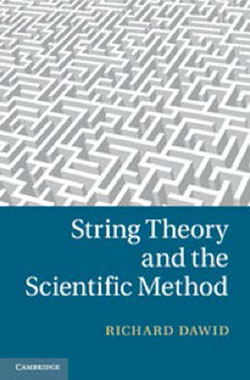String Theory and the Scientific Method
By Richard Dawid | Cambridge: Cambridge University Press, 2013, 210 pp., $95 (hardback)
Reviewed by Robert P. Crease

In what Dawid calls the “classical paradigm of theory assessment” of traditional Anglo-American philosophy of science, the scientific process can be neatly parsed into a core body of confirmed knowledge, speculations, and testing of such speculations. String theory, however, is notoriously empirically untestable at present, and almost certainly will continue to be so for decades. According to classical philosophy of science, therefore, it should have negligible scientific status. For precisely that reason, critics such as Lee Smolin and Peter Woit have condemned its influence. Yet as Dawid writes, other theorists regard string theory as “well-established and authoritative.” Theoretical physicists seem schizophrenic on the subject; while many find string theory “too good to be false,” others see it as evidence of groupthink. Dawid’s book addresses precisely this discrepancy: “the serious mismatch between the status one would have to attribute to string theory based on the canonical paradigm of theory assessment and the status the theory actually enjoys.” The classical paradigm is wrong, Dawid concludes, and he seeks to correct it by arguing for the relevance of “non-empirical theory assessment.”
Thomas Kuhn effectively invoked non-empirical theory assessment in his Structure of Scientific Revolutions (1962), but confined it to the choice between paradigms in revolutionary science. In Progress and its Problems (1977), Larry Lauden saw a role for non-empirical theory assessment in more everyday scientific practice. Dawid begins his argument with “scientific underdetermination,” or the fact that when one promising theory points to a certain empirical outcome, a host of other less promising ones will do likewise, meaning that other factors must be in play to account for the theory’s desirability. The scientific underdetermination, Dawid concludes, is “limited.” Dawid proposes three such limitations to account for the promise of string theory: the “No Alternatives Argument” (NAA), or the fact that string theory is the only available option for constructing a unified theory of quantum interactions and gravity; the Unexpected Explanatory coherence Argument (UEA), or the fact that string theory has provided unexpected deeper explanations of seemingly disparate concepts; and the Meta-Inductive Argument (MIA), based on an analogy between string theory and the earlier research program that led to the Standard Model.
Dawid concludes that the “precarious empirical status” of contemporary physics stems in large part from “the general mechanism” that has driven physics for a half-century; namely, steadily rising collision energies in experimentation and the increasing role of gauge symmetries in theory-building. He calls the outcome the “marginalization of the phenomena.” He also argues that string theory is a candidate for a truly final theory, for it implies, by its structure, a limit to new physics.
In making the extended argument that the “canonical reconstruction of scientific theory assessment in physics is inadequately narrow,” Dawid keeps his feet firmly planted within the narrow confines of the Anglo-American philosophical tradition, which is focused on developing a logic of science. He does not, for instance, draw from Science, Technology, and Society (STS) studies, whose starting point is the actual practice of science. Nor does Dawid consider Continental approaches (such as Husserl’s) that do not begin by attempting to tell scientists how they work, logically speaking, but by examining meaning-formation in scientific experience. Dawid’s “brief excursion” into palaeontology would have been more profitable had it recognized that paleontologists make progress less by speculating about and confirming underdetermined theories than by understanding the worlds inhabited by dinosaurs, a much different process.
String Theory and the Scientific Method is clearly written and well argued, one of the clearest expositions of string theory accessible to a non-physicist that I have read. Though narrowly conceived, and yearning to be informed by a broader philosophical perspective, it is an important contribution to traditional Anglo-American philosophy of science insofar as its initial inspiration is not the urge to develop the logic of science for its own sake, but the mismatch between the inherited picture of that logic and the actual experience of scientists.
The articles in this issue represent the views of their authors and are not necessarily those of the Forum or APS.
